As an Amazon Associate I earn from qualifying purchases.
Can you eat roosters? Yes, you can eat roosters.
Here is a story about a strange gift, an unusual challenge, and three very old, very ornery roosters. And as you may well guess, it ends badly for the roosters. To a point.
I have become something of our Italian neighbors’ personal rooster assassin. I killed my first two years ago, and have returned at their behest several times since. Dominic and Rosa raise chickens, and those chickens lay eggs and those eggs hatch and some of them become roosters. Dominic and Rosa do not eat their chickens, so those roosters grow to reach their full roosterhood. And there are a lot of them in their coop.
You can imagine what happens when you get 20 guys in a confined space, all with eyes on those 10 girls. It is a game of musical chairs that half of those playing will lose. And roosters are sore losers. Armed with vicious spurs, they can and do attack each other, much the same way drunk frat boys do on Saturday nights.
Think of me as the bouncer. Usually I deal with the rooster equivalent of a frat boy — the last bunch I “took for a ride” were just four months old. These were some tasty birds, and the Rooster Dordogne I made from them was outstanding. Would I be so lucky this time?
Holly and I were just about ready to head to Napa to visit friends (and hunt turkeys) when we heard a knock on the door. It was Rosa. She said she had a gift of three roosters ready for us. Now. In a sack. In the car.
It is not often you get a neighbor knocking at your door offering you three live roosters, which she has so kindly bagged for you. Even here, this is uncommon at the very least. With great regret I told Rosa I could not deal with these roosters until the following week. She said OK, that she’d keep them separate in a cage until the following Saturday.
Enter the Food Bloggers. It occurred to me for some inexplicable reason that my friends Garrett and Elise might want to come over and watch/help/stand in horror while I did the deed. Then I remembered the conversation I’d had with Biggie, who destroyed me in the Well-Fed Network’s Best Food Blog contest this past winter. Biggie had wanted to learn how to break down whole animals into serving portions, and while the original idea was a pig or a goat, I suggested we could start with a chicken. She said she was game.
So everyone arrived, and I donned some heavy leather — remember, these are roosters with spurs they know how to use. We wandered over to the chicken yard, and I expected the roosters to be in something like a rabbit hutch. No such luck.
When I saw the “cage” I immediately thought of Thunderdome. The three roosters were living in a 10-foot square enclosure with a roof (roosters can fly) made from, well, stuff. Chain link, piping, boxes, random bits of metal, an old car door, etc. And I needed to extract these birds from this place, the interior of which was littered with old bathtubs, buckets, pipes that served as pillars and other debris.
Dominic’s net didn’t do me much good, either. The net at some point in the Jurassic Period has been a large fishing net, but Dominic had repaired it over and over and it only just barely was still a net; actually it was more like a giant homemade tennis racket.
Into the cage I went, and when I saw the roosters my heart tightened: These were very old birds. Huge, eight-pound plus birds. I remembered Rosa mentioning something about these three being the ringleaders in the coop. I also remembered her mentioning something about them being several years old, not months like the last bunch.
And I had an audience, snapping pictures no less. (Elise took most of the photos for this post.) These roosters had been freely ranging in the coop long enough to build up a healthy set of running legs, so there was much running and feinting and bobbing and weaving; think about that scene in “Rocky.” Eventually I managed to slap the net down on one of them.
Now what? Well, this is where I kill the rooster by spinning it like a helicopter, breaking its neck. An ugly business, but at least it’s quick. On to the second rooster. He was cagier, but I caught him, too — although this bruiser broke Dominic’s net.
With one more bird to go and no net, I needed Garrett’s help. Garrett grew up with a relative who raised chickens, so he sorta remembered what he needed to do. We attempted to corner the bird — while trying to avoid the spurs — and Garrett just about got his hands on it when FOOM! The rooster found a hole in the cage and exploded into the air like a moon rocket.
Sweating and out of breath, I looked at Garrett: “Two out of three ain’t bad.” Rooster No. 3 would live to crow another day.
So there we were, with a pair of old, dead roosters in a burlap sack. Now they needed to be plucked, and plucking a chicken is a smelly job — far smellier than plucking pheasants or ducks.
I scald my birds in hot water the same way I pluck a pheasant. After that, I pluck as fast as I can while the bird is still warm; it goes quickly.
Then Biggie and Elise and Garrett got into the act. The first bird was a tester, so I could show them the fine art of chicken plucking, such as it is: Wings first, then back, then tail, along the keelbone, legs then neck.
Their rooster was the older of the two, and significantly larger. I kept thinking as they plucked. “What the hell am I going to do with these birds?” Old birds are tough birds. This would be a challenge.
“Oh my!” Elise had turned over their rooster and noticed its spurs. I just about had a heart attack — the spurs were nearly three inches long, curved and very, very sharp. But for the Grace of God that rooster could easily have sent me to the hospital. I was feeling a lot better about leaving that last bird, and was beginning to understand why Dominic and Rosa never killed their own chickens.
Once plucked, we broke down the roosters into serving pieces, and the others marveled at how red the meat was. Store-bought chicken may be the Original White Meat, but a “walkin’ around” rooster that has several summers under its spurs reddens even more than a wild pheasant, which typically only lives a year or two.
I sent Garrett home with the carcasses for stock. Rooster stock is by far the finest chicken stock in the world. It will give you the strongest chicken flavor possible, so much so that I label it “Rooster Stock” to separate it from the regular pheasant and chicken stock I make.
The rest, I decided, would become sausage.
Notice how dark these links are? They are darker even than some of the pork I have used. Let me tell you that the legs of these birds were so tough I think I dulled my knife on the tendons. The only animal with stronger sinews I can remember was a geriatric mule deer doe I shot in Montana.
I added some pork fat and then flavored the sausages with lots of fresh garlic, some fennel seeds, the zest of a lemon and lots of fresh oregano, plus some Madeira. I tossed in the liver, heart and gizzards for good measure. Here is the recipe.
How were they? “Chewy,” Elise said. “But really flavorful.” I concur. If I had it to do over again I would spend more time removing sinew and silverskin, and I would grind the meat and fat a second time through a finer die, hopefully creating a smoother sausage. (this is reflected in the recipe above.) We ate some tonight loose in a tomato sauce with pasta, and it was better.
In the wider world, these roosters are an anomaly. Roosters are killed and eaten at 6-8 weeks in factory farms, well before they develop the attitude (and the parts) of a full-grown rooster. Even in traditional farms, roosters (unless they are the breeders) rarely make it past a year; the oldest chickens in a barnyard are typically laying hens. A five-year-old rooster is a rare thing indeed, although they can theoretically live into their teens.
Biggie, Elise and Garrett all said they were glad to be able to see something go from living animal to plated dish — not “glad” as in happy, so much as gratified to have been able to see what so few of us see anymore. It is not a pretty thing, killing a bird. But it happens many millions of times every week in America; Dominic and Rosa’s roosters lived far longer than most of their brethren. And old and tough as they are, these birds won’t go to waste.
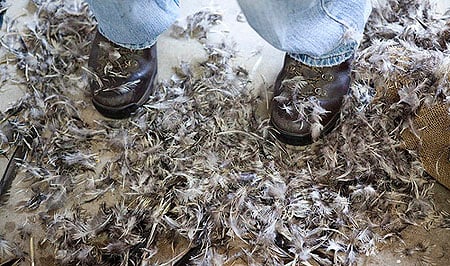
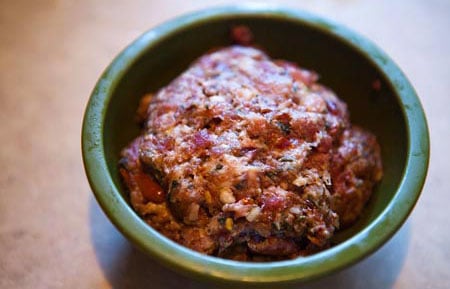

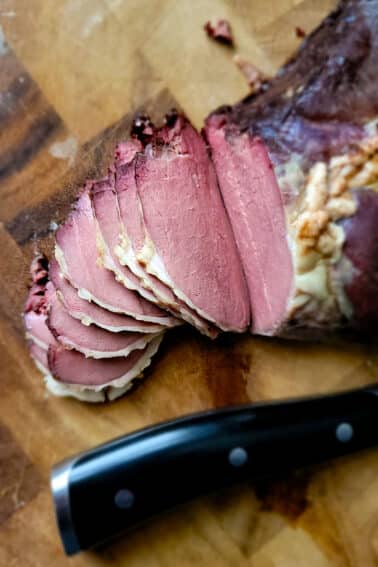
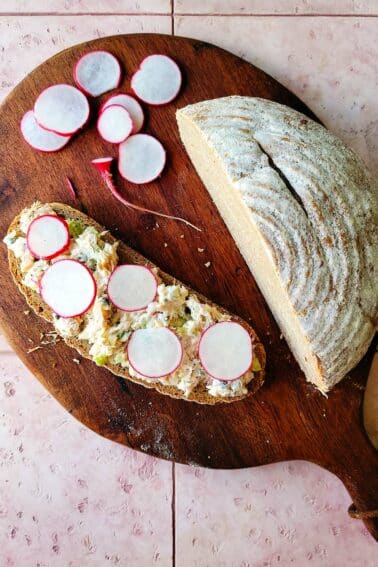
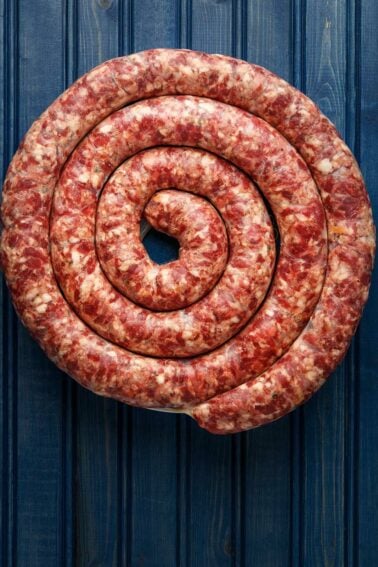
Hi Hank,
Thanks for the laugh! We live in Orange, NSW, Australia and did a google search on what’s the best age to eat a rooster and you came up.
I read it to my wife and we were having a good laugh. Classic story! Loved “Thunderdome”.
Cheers,
Scott
Tammie – not quite that simple. If you can (i.e. the chicken isn’t as risky to catch as in the story) it’s best for the meat to cut the arteries in the neck while the bird is calm rather than break its neck. Buy or make a cone that will fit the chicken, and put it head first in the cone (an orange road cone with the narrow end opened up a bit will work). The chicken will calm down quickly and you can then use a VERY sharp knife to cut the neck. Just one side in the semi-bald spot below the ear. Try not to sever the trachea or esophagus. Give a minute or two and it will fully bleed out. Scald by dunking and swirling in 145-150F water for about 10 seconds at a time then lifting out to drain. After 3-4 dunkings try pulling a wing or tail feather. Keep dunking until they pull reasonably easily. Then hang the bird by a foot and get to plucking. Once all feathers are removed (should take 5-10 minutes) you’ll need to remove the head, feet, and guts from the bird. There’s lots of videos on the internet showing some good tricks for this. Look up Joel Salatin for a great tutorial. Once gutted, either cut up or package whole. Regardless, let it rest in the fridge for 1-2 days before cooking or freezing to let rigor mortis relax and some degree of aging to occur. This will make the meat much more tender and flavorful.
So I catch the rooster and spin it by the neck and put in hot water and cut up to. Eat. Right??
I currently have far more roosters than I never imagined, one of my chickens went broody and I thought it would be a good idea to let her sit on a dozen of eggs, she hatched thirteen chicks, yes she hatched a set of twins, from those chicks five are roosters and I still have one tha I’m not sure about it, she is taller it has not crowed yet, they are five monthe old, the first of the roosters started crowing when it was five weeks old, I want to eat them, I feel sorry for their fate but I don’t need so many, I hoped for girls but I don’t always get lucky, I went to a breeder and bought nine chicks, well eight of them are roosters, plus my chicken hatch another batch of three roosters, well the case is that I’m going to fill up my freezer with delicious birds because all of them have to go in one night.
I use to kill my roosters back in Mexico, yes your helicopter system brought back memories I use to do it to my roosters. Lol. I loved your story.
We kill our free range rooster’s just on a month when they have started to crow. They are still tender, tasty, dark meat and easy to deal with. I use the skin the bird and remove just the legs, breast, lungs and heart. The carcass is buried in the vegy garden for the blood and bone.
I normally boil the meat in a cast iron pot with onions and bay leaves for 45 minutes and leave to cool down gradually. Then we recook the meat into other dishes. A cassole with coconut cream and other chopped veges makes for a yummy dish.
Buy sexed eggs and chicks. Unsexed are nearly all roosters. Don’t buy Leghorns for free ranging – they’re STUPID and eat nails and get run over by plows and…. Don’t buy Banties for free ranging – they’re SMART and will roost in trees and bushes where you can’t catch them. They will also take over the entire neighbourhood because they will mate with anything including cats. If you want eggs, buy geese. Geese and ducks are tons cheaper to feed.
Been there, done that, burned the T-shirt.
nice blog, i found you once removed from an award my wife won. sadly our roosters are usually wasted. this summer will be the first time we have our automatic chicken plucker. we hope to not waste the roosters anymore.
karl
Love your blog! Another cooking option may be the pressure cooker – no long simmer/braise. We just dispatched a who-knows-how-old rooster for our Easter dinner. My husband wanted me to try frying it instead of the chicken-N-dumplins I usually do and boy was that a mistake. As you said, the meat looks beautiful going into the pan but it comes out like rubber. Ive never thought about chicken/rooster sausage before. I’ll have to try that. Thanks for the idea and the recipe.
Nice post and weblog. Our farmer’s market has an egg vendor that has started selling slaughtered laying hens. Cook ’em long enough and they are just ridiculously yummy and tender. Don’t cook ’em long enough and they are chicken bubblegum!
A couple of years ago, a friend of mine and I took it upon ourselves to go harvest a turkey for Thanksgiving.
https://www.friday.com/bbum/2008/03/03/how-to-harvest-a-turkey-2/
Great post!!! We killed, plucked, butchered and cooked & ate our first home-grown rooster back in November. We have hens for eggs, but due to rules where we live, roosters are forbidden– more due to the potential for feral chicken populations than the noise of crowing, since we’re very rural. We too had help: our friend & neighbor did the killing as this was a first for me & my family, but we all helped with the capturing and witnessed the act, so to speak. My * year old and I did the plucking, and our experienced hunter friend helped with the butchering.
Like you said, we were all “glad” to have been a part of it. Not happy, but grateful for the experience and understanding. And grateful for that wonderful tasting, healthy bird! He was about 12 weeks old and already getting tough, so I can only imagine how tough your roosters were!
Wonderful story, Hank! Your comment about the normal age of roosters makes me think about one particular guy we have running around our neighborhood. It’s an escapee obviously and has been haunting the lower reaches of a city park near or home for a few years at least. His stomping ground is in view of Lake Washington and takes in a rather pastoral setting despite the urbanity all around. He must be one tough sumbeech to weather the coyotes, stray dogs, great horned owls, and other potential foes, not to mention bored teenagers. Probably has spurs of steel!
I raise 300 to 400 meat birds a year, Gary is right about bleeding them out. It makes a big difference. Also, catch them the night before and put them in small cages and withold food from them, it’s much easier and cleaner processing them when their crops and intestines are empty.
You also want to keep everything as calm as possible, chasing them around will only cause bruises, broken legs and wings, and tough birds. We live about 30 miles outside Detroit, anyone is welcome to visit our disassembly line and watch or participate. We process 3-4 times each summer, doing 100 birds each time, it takes 4-5 people about 5 hours including cleanup.
I also have a really neat little design for a small backyard layer pen that moves around the yard (to give the birds access to fresh pasture and spread the manure around). It’s perfect for 3-5 hens, easy to build, easy to move and access, and attractive. I can try to explain it or send a sketch if anyone is interested.
Our spent hens we roast in big batches, cut up the breast meat and freeze for quick additions to winter recipes, then blacken the rest of the carcass in the broiler with carrots, onions, and celery. We then make huge batches of roasted chicken stock which we freeze in one cup freezer bags. We also freeze a bunch in the ice cube trays, then transfer the cubes to bags for using smaller amounts in recipes.
Does anybody else find the city of Sacramento’s aversion to its agricultural heritage and Central Valley roots so tiring? I mean, c’mon … Embrace your inner ‘Cow Town.’ The city should celebrate its rich cultural heritage and agricultural past and allow a few backyard hens. Sophisticated cities such as New York have no problem with this and no inferiority complex, certainly. Good luck with the campaign, Katie.
Gary: If I raised chickens, I would do the same thing. This rooster killing happens so infrequently it is not worth it to set up a “kill cone.”
NTSC: You are very correct that coq au vin is made with a rooster, but trust me when I say that if you made it with these birds you would need to simmer it for 8-10 hours. It would prolly still be good, but just very time-consuming.
EAT Sacramento (a newish community group focusing on food security) is working on legalizing chickens in Sacramento. If you (or your chicken harboring neighbors) are interested in helping out with that, we’d love for people to write letters to the mayor’s office.